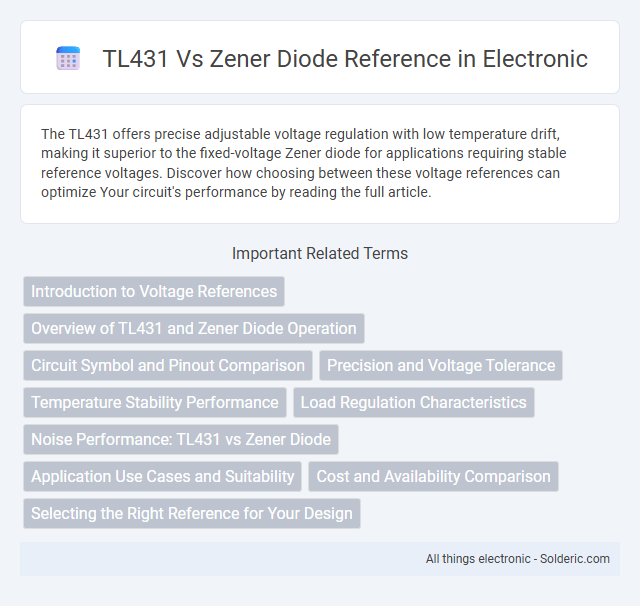The TL431 offers precise adjustable voltage regulation with low temperature drift, making it superior to the fixed-voltage Zener diode for applications requiring stable reference voltages. Discover how choosing between these voltage references can optimize Your circuit's performance by reading the full article.
Comparison Table
| Parameter | TL431 | Zener Diode Reference |
|---|---|---|
| Type | Adjustable shunt voltage regulator | Fixed voltage regulator diode |
| Voltage Range | 2.5V to 36V (adjustable) | Typical 2.4V to 200V (fixed) |
| Accuracy | +-0.5% to +-2% | +-5% to +-20% |
| Temperature Stability | Better temperature coefficient (~50 ppm/degC) | Higher temperature drift (up to several mV/degC) |
| Adjustability | Yes, via external resistors | No, fixed voltage |
| Noise | Low noise | Higher noise |
| Applications | Precision voltage reference, switching power supplies, adjustable regulators | Voltage clamp, over-voltage protection, basic voltage reference |
| Cost | Moderate | Low |
| Power Dissipation | Up to 1W (depends on package) | Typically low, depends on zener rating |
| Package Types | TO-92, SOT-23, TO-220 | DO-35, SOD-123, DO-41 |
Introduction to Voltage References
Voltage references provide a precise, stable output voltage essential for analog and digital circuits. The TL431 offers an adjustable voltage reference with superior temperature stability and low dynamic impedance compared to traditional Zener diode references. Zener diodes, while simple and cost-effective, exhibit higher voltage drift and noise, making the TL431 preferable for high-accuracy applications.
Overview of TL431 and Zener Diode Operation
The TL431 is a programmable shunt voltage reference that provides precise voltage regulation with adjustable output, operating as an internal op-amp with a stable voltage reference of 2.5V at its reference pin. Zener diodes function by maintaining a nearly constant voltage across their terminals when reverse-biased beyond their breakdown voltage, typically used for voltage clamping and simple reference applications. Compared to the Zener diode, the TL431 offers improved accuracy, temperature stability, and flexibility for precision voltage regulation in electronic circuits.
Circuit Symbol and Pinout Comparison
The TL431 features a three-terminal adjustable shunt regulator symbol, with its reference (Ref), cathode (K), and anode (A) pins clearly marked, allowing precise voltage reference settings. In contrast, the Zener diode uses a simpler two-terminal diode symbol with only anode and cathode pins, providing a fixed voltage drop based on its Zener voltage rating. The extra terminal in TL431 offers enhanced functionality for voltage regulation circuits, distinguishing it from the basic Zener diode configuration.
Precision and Voltage Tolerance
TL431 offers superior precision and tighter voltage tolerance compared to Zener diodes, making it ideal for applications requiring accurate voltage regulation. With programmable reference voltage and typically +-1% tolerance, TL431 outperforms Zener diodes, which often have +-5% or worse tolerance. For your circuits demanding stable voltage references, choosing TL431 enhances reliability and performance.
Temperature Stability Performance
The TL431 shunt regulator offers superior temperature stability compared to Zener diodes, with a typical temperature coefficient of +-2 mV/degC versus +-10 mV/degC for standard Zener diodes. This improved stability makes the TL431 ideal for precision voltage reference applications in varying environmental conditions. As a result, TL431-based circuits maintain more consistent voltage levels over wide temperature ranges, enhancing overall device reliability.
Load Regulation Characteristics
TL431 offers superior load regulation compared to standard Zener diodes, maintaining a stable reference voltage across varying load currents due to its adjustable shunt regulator design. The TL431's internal feedback mechanism allows it to respond dynamically, resulting in less voltage variation under load changes, typically within millivolts. Your circuit benefits from enhanced precision and reduced noise when using a TL431 for voltage reference in sensitive applications.
Noise Performance: TL431 vs Zener Diode
The TL431 voltage reference offers significantly lower noise performance compared to traditional Zener diodes, making it ideal for precision applications. While Zener diodes typically generate higher noise levels due to their avalanche breakdown mechanism, the TL431's bandgap reference design ensures more stable and cleaner output voltage. Using the TL431 can improve your circuit's signal integrity by reducing voltage fluctuations caused by noise.
Application Use Cases and Suitability
The TL431 offers precise voltage regulation and is ideal for applications requiring adjustable reference voltages, such as power supplies, battery chargers, and voltage monitoring circuits. In contrast, Zener diodes provide fixed voltage references suited for simple, low-cost designs with moderate accuracy needs, commonly used in voltage clamping and protection circuits. Your choice between TL431 and Zener diodes depends on the required voltage precision, stability, and complexity of the application.
Cost and Availability Comparison
The TL431 shunt voltage reference generally offers better precision and stability at a slightly higher cost compared to standard Zener diodes, which are typically more affordable and widely available. Zener diodes are found in diverse packaging and voltage ratings, making them easier to source in bulk for low-cost applications. Despite the higher unit price, the TL431's improved performance and adjustable output voltage make it the preferred choice in precision regulation circuits, though Zener diodes remain dominant in cost-sensitive, less critical designs.
Selecting the Right Reference for Your Design
Choosing between a TL431 and a Zener diode reference depends on precision and flexibility requirements; the TL431 offers adjustable voltage output with tight tolerance and low temperature drift, making it ideal for voltage regulation in complex circuits. Zener diodes provide a simple, cost-effective fixed reference with moderate accuracy suitable for basic voltage clamping or reference tasks. Evaluating load conditions, voltage stability, and accuracy demands ensures optimal component selection for reliable and efficient circuit design.
TL431 vs Zener diode reference Infographic

 solderic.com
solderic.com